
Drosera, which is commonly known as the sundews, is one of the largest genera of carnivorous plants, with at least 194 species. These members of the family Droseraceae lure, capture, and digest insects using stalked mucilaginous glands covering their leaf surfaces. The insects are used to supplement the poor mineral nutrition of the soil in which the plants grow. Various species, which vary greatly in size and form, are native to every continent except Antarctica.

Pygmy marmosets are two species of small New World monkeys in the genus Cebuella. They are native to rainforests of the western Amazon Basin in South America. These primates are notable for being the smallest monkeys in the world, at just over 100 g (3.5 oz). They are generally found in evergreen and river-edge forests and are gum-feeding specialists, or gummivores.

Drosera pedicellaris is a pygmy species of the sundew genus (Drosera). It was discovered in 1997 and described in 2002 by Allen Lowrie.
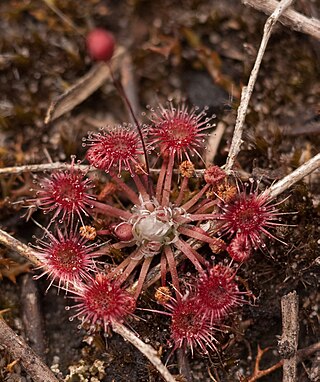
Drosera pygmaea is a carnivorous, rosette-forming biennial or annual species of herb native to Australia and New Zealand. The specific epithet, which translates as "dwarf" from Latin, is a reference to the very small size of this plant, which grows to between 8 and 18 mm in diameter. Small, pale flowers are produced at the ends of 1- to 3-inch stems. It is perhaps the most well-known of the pygmy sundews.
Drosera gibsonii is a species of pygmy sundew endemic to Stirling Range National Park in Western Australia. It is thought to be most closely related to Drosera silvicola.
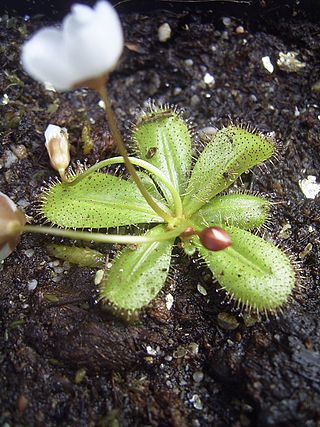
Drosera tubaestylis is a perennial tuberous species in the genus Drosera that is endemic to Western Australia. It grows in a rosette about 2 to 3 cm in diameter. It is native to an area near Perth. It grows in fine sandy clay soils at the margins of swamps. It is considered to be related to D. bulbosa. The species is named for the trumpet-shaped style apices. It was first formally described by Allen Lowrie and N. G. Marchant in 1992.
Drosera orbiculata is a perennial tuberous species in the genus Drosera that is endemic to Western Australia. It grows in a rosette about 1.5 cm in diameter. It is native to an area 1.3 km north of Gillingarra near Perth. It grows in sandy clay soils in winter-wet depressions and washes. It is considered to be related to D. rosulata. The species is named for the shape of the leaf lamina. It was first formally described by Allen Lowrie and N. G. Marchant in 1992.
Drosera lowriei is a perennial tuberous species in the genus Drosera that is endemic to Western Australia. It grows in a rosette about 3 cm in diameter. It is native to an area northwest of Esperance. It grows in loam soils in wet zones near granite outcrops. It is considered to be related to D. zonaria. It was first formally described by N. G. Marchant in 1992 and named in honour of Allen Lowrie.

Drosera dielsiana is a compact rosetted sundew native to South Africa, Eswatini (Swaziland), Mozambique, Malawi, and Zimbabwe. It was described as a new species by Arthur Wallis Exell and Jack Rodney Laundon in 1956. The diploid chromosome number is 2n=40. It was named in honor of Ludwig Diels, the author of the 1906 monograph on the Droseraceae.
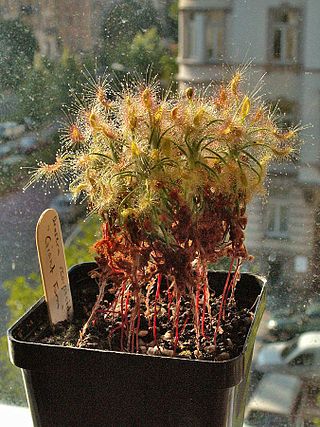
Drosera scorpioides, commonly called the shaggy sundew, is a pygmy sundew native to the Jarrah Forest region and southern coasts of Southwest Australia. Notable for its unusually large size relative to other pygmy sundews, D. scorpioides can produce rosettes measuring up to two inches in diameter and specimens may attain a height of up to 100 millimeters. The species is found on white sand and clay, near swamps, on sand ridges, and is associated with laterite. The flowers are pink and white, appearing sometime between August and October. Depending on the form, D. scorpioides can be expected to live up to seven years.

Drosera menziesii, the pink rainbow, is an erect or scrambling perennial tuberous species in the carnivorous plant genus Drosera. It is endemic to Western Australia and grows in a variety of habitats, including winter-wet depressions, swamps, and granite outcrops in clay or peat sand soils or loam. D. menziesii produces small, circular carnivorous leaves along an undulating erect stem that can be .05–1.1 m (0.2–3.6 ft) high. Its pink flowers emerge from July to November.
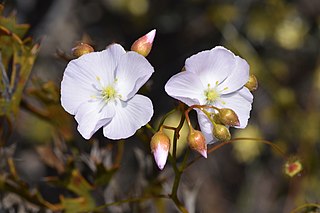
Drosera drummondii is a plant in the family Droseraceae, native to Western Australia.
Drosera salina is an erect perennial tuberous species in the carnivorous plant genus Drosera. It is endemic to Western Australia and is only found in salt-free sand on the margins of salt lakes in a few locations north of Albany east to north-west of Esperance. The specific epithet, salina, refers to the salt lake margins that this species inhabits. D. salina produces small carnivorous leaves along stems that can be 7 cm (3 in) high. White flowers bloom from July to September.

Drosera meristocaulis is a perennial species in the carnivorous plant genus Drosera, the only member of the subgenus Meristocaulis. It is a small, rosette- and branched stem-forming sundew that has many morphological affinities to the Australian pygmy sundews. D. meristocaulis is wholly endemic to Pico da Neblina, an isolated mountain on the Brazil-Venezuela border.
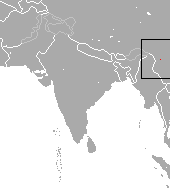
The pygmy brown-toothed shrew is a species of shrew in the order Eulipotyphla. It is distributed in China. C. parva was initially thought to be the same as Chodsigoa lamula, but it was found to be a separate species.

Drosera sargentii is a species of pygmy sundew from Western Australia.
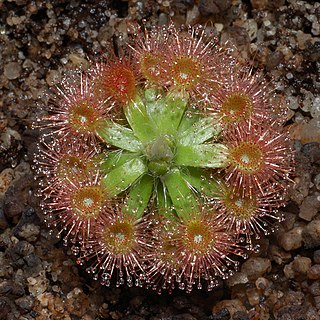
Drosera pulchella, a type of pygmy sundew , is a species of carnivorous plant native to southwestern Australia. As their common name suggests, they are a small species that usually 15 to 20 millimeters wide. They typically grow in clusters that completely cover an area like a patch of moss. The namesake sticky dew at the ends of their leaves is designed to trap insects so that the plants can absorb nutrients as the insect decomposes.

Drosera citrina is a pygmy sundew, a type of carnivorous plant. It is native to Western Australia. The Latin specific epithet citrina means "lemon coloured", refrring to the colour of the flowers. It is closely related to Drosera nivea, which was considered a variety of D. citrina in the past called Drosera citrina var. nivea
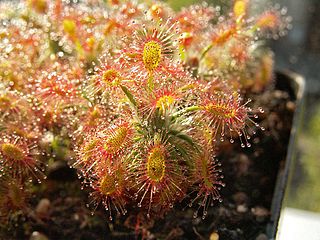
Drosera dichrosepala, commonly known as the rusty sundew, is a pygmy sundew from Western Australia. It is a carnivorous plant. The specific epithet dichrosepala is a combination of the Greek words dis, meaning double, and chroia, meaning colour, as well as the Latin sepalum meaning sepal, it refers to the plant's sepals being bi-coloured. It has two subspecies: D. dichrosepala ssp.dichrosepala and D. dichrosepala ssp. enodes.
Drosera nivea is a species of carnivorous plant. It is a pygmy sundew and is native to Western Australia. The specific epithet nivea is derived from the Latin word niveus, meaning white, in reference to the colour of the plant's flower. It is closely related to Drosera citrina and has previously been considered a variety of D.citrina known as D. citrina var. nivea.

















